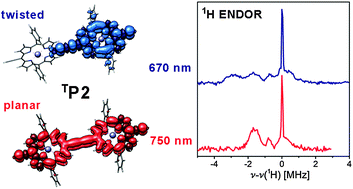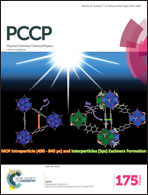Excitation wavelength-dependent EPR study on the influence of the conformation of multiporphyrin arrays on triplet state delocalization†
Abstract
The optoelectronic properties of conjugated porphyrin arrays render them excellent candidates for use in a variety of molecular electronic devices. Understanding the factors controlling the electron delocalization in these systems is important for further developments in this field. Here, we use transient EPR and ENDOR (Electron Nuclear Double Resonance) to study the extent of electronic delocalization in the photoexcited triplet states of a series of butadiyne-linked porphyrin oligomers. We are able to distinguish between planar and twisted arrangements of adjacent porphyrin units, as the different conformations are preferentially excited at different wavelengths in the visible range. We show that the extent of triplet state delocalization is modulated by the torsional angle between the porphyrins and therefore by the excitation wavelength. These results have implications for the design of supramolecular systems with fine-tuned excitonic interactions and for the control of charge transport.


 Please wait while we load your content...
Please wait while we load your content...